How Do You Know if You Violate a Fastrak Toll Tag Cost

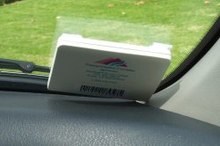
Mounted FasTrak transponder
FasTrak is the electronic toll collection (ETC) organisation used in the land of California in the United States. The organisation is used statewide on all of the toll roads, toll bridges, and high-occupancy cost lanes along the California Freeway and Expressway System.
Equally with other ETC systems, FasTrak is designed to eliminate the need for cars to stop to pay at toll booths, thus decreasing the traffic congestion traditionally associated with toll roads. Its use of technology to better transit is in line with the U.S. Department of Transportation's Intelligent Transportation Systems initiative.
Under California's regime structure, the land'south toll facilities are operated by various agencies and special-purpose districts. Concerned that they would each innovate unlike, incompatible ETC systems, the California Land Legislature passed Senate Pecker 1523 in 1990, requiring the California Section of Transportation (Caltrans) to develop a statewide specification that all these toll agencies were required to come across.[1] Three years later on, Transportation Corridor Agencies opened the Foothill Cost Road in Orange County, implementing the statewide ETC system for the start time, and naming it FasTrak. The state continues to delegate the responsibility of selling and maintaining FasTrak accounts to the different toll agencies.
Operations and functionality [edit]
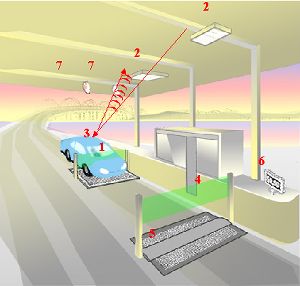
Diagram of FasTrak toll collections organisation. As the vehicle enters the toll lane, sensors (i) observe the vehicle. The two-antenna configuration (two) reads a transponder (3) mounted on the vehicle's windshield. As the vehicle passes through the exit light curtain (iv), it is electronically classified by the treadle (5) based on the number of axles, and the ETC business relationship is charged the proper amount. Feedback is provided to the driver on an electronic sign (6). If the vehicle does not have a transponder, or if a transponder is not detected at the toll plaza, the system classifies it every bit a violator and cameras (7) take photos of the vehicle and its license plate for processing. If the license plate is registered as belonging to a FasTrak user, the account is debited only the price accuse, and no penalty is charged.
Under California police, the California Department of Transportation (Caltrans) was given the mandate to develop and maintain an open up, statewide ETC specification. This specification is known in the transportation manufacture as "Championship 21" after it was added to Title 21 of the California Code of Regulations. FasTrak uses RFID technology near 915 MHz to read data from a transponder placed in a vehicle (unremarkably mounted by Velcro strips to the windshield) moving at speeds that may exceed 70 mph (112 km/h). The RFID transponder in each vehicle is associated with a prepaid debit account; each time the vehicle passes underneath a toll collection site, the account is debited to pay the price.
Currently, FasTrak transponders are not uniform with E-ZPass and other ETC systems used in other states considering they use a different specification than Championship 21. If a vehicle does not have a transponder, or if a transponder is not detected at the toll plaza, a violation enforcement system triggers cameras that capture photos of the vehicle and its license plate for processing. If the license plate is registered as belonging to a FasTrak user, the business relationship is debited only the toll charge, and no penalty is charged. This is a backup in example a transponder fails to read. Otherwise, a toll violation notice is sent to the registered owner of the vehicle.[2] In the case of drivers whose vehicles are company owned or leased, as long equally the vehicle license plates are properly listed, the violations will exist sent to the registered owner and not the employee commuter. It is for this reason that the License Agreement mandates that customers listing all vehicles, including motorcycles, motor homes, and trailers of all types on their accounts so that when transponders fail to read the toll can be debited based upon the vehicle'south license plate. A license plate may be listed merely on one account.
A price collected based on a license plate is chosen an Image Toll and can be identified on the customer statement by noticing the license plate number listed instead of the transponder number. If 1 fails to correctly listing license plates on their account, the FasTrak customer will receive price violation notices as if they were some other driver. If a FasTrak client receives a price violation find under these circumstances, they just refer to the opposite side of the Price Violation notice and complete the department at the bottom of the notice that will add the new vehicle to their account. Conversely, a license plate should be removed from an account later on a alter in ownership, otherwise resulting in paying for another driver's tolls via the Paradigm Cost process.
Service eye operations [edit]
Each toll bureau in Southern California has their own billing and customer service center. For convenience, all price facilities in the San Francisco Bay Area instead share the aforementioned billing and customer service center. Although anybody with a FasTrak transponder tin use it to pay tolls on whatsoever California toll facility using the system, people are encouraged to open their accounts with the local agency in charge of the 1 that they apply the about. Each heart establishes its own fee and discount structures, and people may be charged a fee if the bulk of their FasTrak use occurs elsewhere.
Fees [edit]
Each FasTrak business relationship agency has its own monthly minimums / monthly fees (from lowest to highest)
| Agency | Surface area | Fee(southward) |
|---|---|---|
| Bay Area FasTrak | San Francisco Bay Surface area | None[three] |
| The Toll Roads of Orange Canton | Orange County | None[iv] |
| Metro ExpressLanes | Los Angeles County | $i monthly account maintenance fee.[5] |
| Interstate 15 Express Lanes | San Diego Canton | $3.50 minimum monthly toll, plus $1 per transponder.[half-dozen] |
| South Bay Expressway | San Diego County | $3.50 minimum monthly toll, plus $ane per transponder.[7] |
| 91 Express Lanes | Orange and Riverside Counties | Account dependent, with plans ranging from a $75 ane-fourth dimension fee with no monthly fees, to a $seven minimum monthly toll.[8] |
| Riverside Express | Riverside County | $40.00 initial prepaid price deposit, plus $ii monthly account maintenance fee.[9] |
Security [edit]
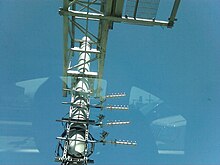
FasTrak antennae that pull information used to generate v-ane-1 traffic information
A teardown assay of the transponder and assay of its security issues was published at Black Chapeau 2008.[10] They are updated remotely, and exercise not use encryption.[eleven] Furthermore, FasTrak'south basic functionality and specifications are listed nether Title 21, Division two, Chapter xvi of the California Lawmaking of Regulations, and are thus freely attainable to the general public.[12]
FasTrak units are used to generate 5-one-i traffic data, using sensors and antennae placed across various freeways.[11]
History [edit]
Equally the offset ETC organisation in North America was installed on the Dallas Due north Tollway in 1989, many California cost facilities started to express interest in the technology. Because the state'south toll roads and bridges are run by different government agencies, there was the possibility that a number of different incompatible ETC systems would exist instituted throughout California. Therefore, the California State Legislature passed Senate Bill 1523 in 1990, requiring Caltrans, the state's Department of Transportation, to develop a statewide technical specification which all systems would be required to meet.[1] As a consequence, California was the starting time in the nation to crave all of its toll bridges and roads to utilise the aforementioned ETC arrangement.[13] This technical specification was later codification in Title 21, Division 2, Affiliate sixteen of the California Code of Regulations.[12]
When the Foothill Cost Road in Orangish Canton opened in 1993, information technology became the beginning California price facility to use an ETC system. Transportation Corridor Agencies (TCA), the local agency in charge of the price road, named the organization "FasTrak".[xiv] To this day, TCA still holds the trademark to the "FasTrak" name and logo.[fifteen]
When TCA first introduced the FasTrak arrangement, the electronic transponders consisted of a gadget almost the size of a Walkman in which a smart card was inserted.[sixteen] Nevertheless, the smart cards were unpopular with both tollway officials and users considering they cost more, offered picayune advantage, and customers were charged with a $ten annual fee (which has since been discontinued).[17] By the fourth dimension the 91 Express Lanes opened in 1995, the FasTrak transponders were redesigned to be the size of a coaster that could be mounted by Velcro strips to the windshield.[eighteen]

Three-lane FasTrak site in Orange County
TCA later deployed the FasTrak organization to the two other price roads they administer as soon as they opened: the San Joaquin Hills Price Road in 1996 and the Eastern Toll Route in 1998. Also in 1998, the organisation was then deployed on the high-occupancy toll (HOT) lanes along Interstate 15 in San Diego.
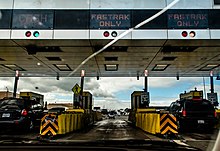
A view of the San Francisco–Oakland Bay Bridge toll plaza in 2008. The center and right price booths are labeled "Fastrak Only", while the left toll booth accepts cash and Fastrak.
However, the organization had to be modified so that it could be used on California'south cost bridges. Later a examination run on the Carquinez Span in 1996, it had accuracy problems in dealing with the 18 different toll classifications for unlike kinds of trucks.[19] After the changes were fabricated and another examination run, the Carquinez Span became the offset California price bridge to use FasTrak in 1997. However, bureaucratic inaction, technical difficulties, and financial mismanagement delayed the deployment of the system to the other half-dozen state-run toll bridges in the San Francisco Bay Area until October 2000.[xx] Meanwhile, the Gold Gate Bridge, run by the contained Golden Gate Bridge, Highway and Transportation District, installed their organization a few months earlier in July of that twelvemonth. The FasTrak system was also briefly used on the state-endemic San Diego-Coronado Span until tolls were discontinued on that structure in 2002. The Bay Surface area FasTrak Customer Center and then opened in 2005, merging the service eye for the land's Bay Area bridges with the ane that was being operated separately by the Golden Gate Span District.[21]
Since then, several other new toll facilities around California accept either opened, are under structure, or are in the planning stages. They are all required to have FasTrak equally per the aforementioned country police force.
In 2009, San Francisco International Airport began accepting FasTrak in all of its parking garages, including long-term parking.[22] Currently only FasTrak accounts opened from either the Bay Surface area FasTrak Client Center or from Transportation Corridor Agencies tin be used at the airport.[23]
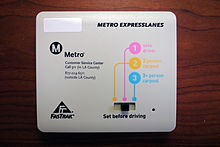
When the Metro ExpressLanes opened in Los Angeles in late 2012, it introduced FasTrak transponders with a special switch that indicates the number of occupants (1, 2, or iii or more than) in the vehicle. This enables the open up route tolling arrangement to automatically compute the carpool or solo commuter toll,[24] as well equally permit the California Highway Patrol to visually cheque to see if in that location are more than or fewer people in the car than indicated on the transponder.[25] For the convenience of their FasTrak customers in the Greater Los Angeles urban expanse who may also use the Metro ExpressLanes, TCA began offer switchable transponders in 2013,[26] and the 91 Express Lanes followed suit by 2015.[27] With the switchable transponders, the violation charge per unit on the Metro ExpressLanes fell to 10 pct from the 20 to 25 percent cheating charge per unit in toll lanes that practice not crave transponders for carpoolers, prompting Alameda County officials to include the system on the and then-planned I-580 Express Lanes.[28] The Bay Area FasTrak Customer Center then started to offering switchable transponders, under the name "FasTrak Flex", in summer 2015.[29] In other HOT lane facilities, drivers "declare" that they are a carpool (and thus do non have to pay a toll) by covering their FasTrak transponder in a mylar handbag.[29]
There has been a push to strictly use open route tolling, accepting only payments via a FasTrak transponder, a toll-by-plate business relationship, or one-fourth dimension payments via online or past telephone instead of cash. All of California's HOT lanes just employ open road tolling. The Golden Gate Span began requiring electronic payments for all tolls in March 2013,[30] and all the Orangish Canton toll roads run by TCA likewise did the same in May 2014.[31] A plan to also eliminate toll takers on all seven of the state-endemic bridges was canonical in 2019.[32] On March twenty, 2020, at midnight, due to the COVID-xix pandemic, all-electronic tolling was temporarily placed in event for those seven country-owned toll bridges, and as of December x, 2020, all of them are at present permanently cashless.[33] The only toll facility that still accepts greenbacks is the South Bay Expressway in San Diego County, but it uses unstaffed toll booths with cash machines that crave verbal change.[34]
Under MAP-21, passed by the Federal regime in 2012, all ETC facilities in the United States must accomplish some course of interoperability by Oct i, 2016. In response, the California Country Legislature passed Assembly Bill 493 in 2013, authorizing Caltrans and the state's diverse toll agencies to assistance develop compatible systems.[35] However, the borderline, which had neither penalisation nor funding fastened, was not met. California regulators afterwards approved a stage-in of transponder engineering using the ISO/IEC 18000-63 (6C) standard, released in 2004, which began in 2018 and is expected to end in 2024. This would allow compatibility with systems used in nearby states of Washington, Colorado, and Utah; and also Kentucky, Indiana, Georgia, Northward Carolina, and Louisiana, plus NationalPass.[36]
In 2019, TCA introduced a sticker transponder to replace the former plastic transponder.[37] [38] [39] The sticker transponder is similar to the eGo Plus toll sticker introduced by TxTag in 2005, SunPass Mini price sticker introduced past SunPass in 2008, and the sticker tag introduced past MnPASS in 2015.
Price facilities using FasTrak [edit]
Current [edit]
HOV two+ indicates that carpools require two or more than persons.
HOV 3+ indicates that carpools crave three or more persons.
† indicates that two-person carpools are tolled differently than those with 3 or more.
| Proper name | Highway(s) | Location | From | To | Direction tolled | HOV | Account bureau | Source |
|---|---|---|---|---|---|---|---|---|
| Toll bridges | ||||||||
| Antioch Span | | San Joaquin River | Antioch | Sacramento County | Northbound simply | HOV 3+ | Bay Area FasTrak | [40] |
| Benicia–Martinez Bridge | | Carquinez Strait | Martinez | Benicia | [41] | |||
| Carquinez Bridge | | Carquinez Strait | Crockett | Vallejo | Eastbound simply | [42] | ||
| Dumbarton Bridge | | San Francisco Bay | Fremont | Menlo Park | Westbound only | HOV ii+ | [43] | |
| Golden Gate Span | | Golden Gate | Marin County | San Francisco | Southbound merely | HOV three+ | [44] | |
| Richmond–San Rafael Bridge | | San Francisco Bay | Richmond | San Rafael | Westbound only | [45] | ||
| San Francisco–Oakland Bay Bridge | | Oakland | San Francisco | [46] | ||||
| San Mateo–Hayward Bridge | | Hayward | Foster City | HOV 2+ | [47] | |||
| Price roads | ||||||||
| Eastern Toll Road | | Orange Canton | Irvine | | All directions | None | The Cost Roads of Orange County | [48] |
| Foothill Price Road | | Oso Parkway near Rancho Santa Margarita | | Both directions | ||||
| San Joaquin Hills Toll Road | | | Bison Ave in Irvine | |||||
| S Bay Expressway | | San Diego County | | | S Bay Expressway | [49] | ||
| High-occupancy toll lanes | ||||||||
| 91 Express Lanes | | Orangish and Riverside Counties | | | Both directions | HOV 3+ | 91 Express Lanes | [fifty] [51] |
| I-15 Express Lanes (San Diego County) | | San Diego County | | | HOV 2+ | I-fifteen Express Lanes | [52] | |
| I-xv Riverside Express Lanes | | Riverside County | Cajalco Route in Corona | | HOV 3+ | Riverside Limited | [9] | |
| I-580 Limited Lanes | | Alameda County | Hacienda Dr in Dublin/Pleasanton | North Greenville Rd in Livermore | HOV ii+ | Bay Area FasTrak | [53] | |
| I-880 Express Lanes | | Alameda and Santa Clara Counties | Hegenberger Rd in Oakland | | † | [54] | ||
| I-680 Sunol Express Lanes | | | HOV 2+ | [55] | ||||
| I-680 Contra Costa Canton Express Lanes | | Contra Costa County | Marina Vista Ave in Martinez | Alcosta Blvd in San Ramon | [56] | |||
| SR 85 Limited Lanes | | Santa Clara Canton | Primal Freeway in Mount View | | † | [57] | ||
| SR 237 Express Lanes | | Mathilda Artery in Sunnyvale | | † | [58] | |||
| Harbor Transitway | | Los Angeles | Harbor Gateway Transit Centre | Adams Blvd | HOV two+ | Metro ExpressLanes | [59] | |
| El Monte Busway | | Los Angeles County | Alameda St in Los Angeles | | † | |||
| U.s. 101 Limited Lanes | | Santa Clara and San Mateo Counties | | Whipple Avenue in Redwood Urban center | † | Bay Expanse FasTrak | [57] [60] | |
Planned or proposed facilities [edit]
The following is a partial listing of toll facilities that are either in the planning or proposal stages:
| Proper noun | Highway(s) | Location | From | To | Direction tolled | Scheduled to open up |
|---|---|---|---|---|---|---|
| I-5 Limited Lanes (North County Corridor Project) | | San Diego Canton | La Jolla Village Drive in San Diego | Harbor Drive in Oceanside | Both directions | 2021-2035[61] |
| United states of america 101 Express Lanes (Silicon Valley Express Lanes Projection southern extension) | | Santa Clara County | Dunne Avenue in Morgan Loma | | 2025 [62] | |
| Usa 101 Express Lanes (San Mateo County Express Lanes Projection northern extension) | | San Mateo County | Whipple Avenue in Redwood City | | Tardily 2022[63] | |
| SR 85 Express Lanes (southern extension) | | Santa Clara County | | Central Expressway in Mountain View | 2023 (to SR 87)[64] | |
| I-405 Limited Lanes (San Diego Freeway Improvement Project) | | Orange County | | | Both directions | 2023[65] |
| I-fourscore Express Lanes | | Solano County | Cherry-red Tiptop Route in Fairfield | | 2021-2026[66] | |
| I-10 Express Lanes Phase 1 (San Bernardino Express Lanes Projection) | | San Bernardino Canton | | | 2023[67] | |
| I-105 Express Lanes | | Los Angeles County | | Studebaker Rd in Norwalk | 2025[68] | |
| I-405 Express Lanes (Sepulveda Pass Limited Lanes Projection) | | Los Angeles County | | | 2028[69] | |
| Eastward Otay Mesa Port of Entry Thruway | | San Diego County | | Otay Mesa East Port of Entry | Unknown, pending at least the completion of the proposed Otay Mesa East Port of Entry.[70] | |
| Foothill-South | | Orange and San Diego counties | | Oso Parkway near Rancho Santa Margarita | Unknown. The project has been opposed by conservationists and ecology groups.[71] |
References [edit]
- ^ a b Halloran, James V., III (September 1992). "Standardizing Electronic Toll Drove". Reason Foundation. Archived from the original on May 27, 2006. Retrieved Apr 27, 2006.
- ^ FasTrak. "Pop FAQs". FasTrak.
- ^ "FAQ: Full general Information". Bay Area FasTrak . Retrieved February 26, 2019.
- ^ "Are at that place whatever monthly fees associated with having a FasTrak business relationship?". thetollroads.com. Transportation Corridor Agencies. Retrieved July 1, 2019.
- ^ "FAQ". Metro ExpressLanes. Los Angeles Canton Metropolitan Transportation Authority. Retrieved February 26, 2019.
- ^ "Go FasTrak". 511sd.com. San Diego Clan of Governments. Retrieved February 26, 2019.
- ^ "FAQ". Southward Bay Expressway. Retrieved February 26, 2019.
- ^ "Getting Started". The 91 Limited Lanes . Retrieved February 26, 2019.
- ^ a b "Information". Riverside Express . Retrieved April xv, 2021.
- ^ Lawson, Nate (August 6, 2008). "Highway to Hell: Hacking Toll Systems" (PDF). BlackHat USA. Root Labs.
- ^ a b Lawson, Nate (Baronial seven, 2008). "FasTrak Talk Summary and Slides". Root Labs Rdist.
- ^ a b California Department of Transportation Segmentation of Traffic Operations (2013). "Title 21 Back up". California Section of Transportation. Archived from the original on December thirty, 2013. Retrieved December 29, 2013.
- ^ Hallissy, Erin (February xx, 1996). "Bay Area Bridges to Offer Electronic Tolls". San Francisco Chronicle. p. A1. Retrieved April 27, 2006.
- ^ Downey, Cheryl (October 4, 1993). "Tollway Officials Must Sell the Public on New Product". Orange County Register. p. A4.
- ^ Transportation Corridor Agencies (April 13, 2006). "Airplane pilot Program Puts TCA FasTrak on Costco Shelves" (Press release). Transportation Corridor Agencies. Archived from the original on May 10, 2006. Retrieved April 27, 2006.
- ^ Downey, Cheryl (August thirteen, 1993). "Toll Tech: iv Ways to Pay: Transportation: Video Enforcement Will Capture License Plates When Drivers Don't Pay on Foothill Toll Route". Orange Canton Register. p. B4.
- ^ Downey, Cheryl (July 29, 1994). "County Tollway Officials Are Having Second Thoughts Most Expensive Cost-Paying 'Smart Cards'". Orange County Register. p. C4.
- ^ Pund, Ernest E. (Dec 24, 1995). "Highway 91 About to Take Its Kickoff Toll". The Press-Enterprise. Riverside, CA. p. A1.
- ^ Nolte, Carl (September 23, 1996). "Automated Tollbooth Applied science Not Nevertheless Ready for Prime Time". San Francisco Chronicle. p. A15. Retrieved April 27, 2006.
- ^ Cabanatuan, Michael (October 5, 2000). "All Bay Cost Spans Finally Going FasTrak". San Francisco Chronicle. p. A1. Retrieved April 27, 2006.
- ^ Golden Gate Bridge, Highway and Transportation District (June vii, 2005). "June 7th Marks Grand Opening of New Regional FasTrak Customer Service Center in San Francisco" (Press release). Gold Gate Bridge, Highway and Transportation District. Retrieved July 5, 2015.
- ^ McCarron, Michael C. (May 15, 2009). "Like shooting fish in a barrel Payment System Will Save Fourth dimension and Help Reduce Emissions" (Press release). San Francisco International Airport. Archived from the original on January two, 2010. Retrieved July 4, 2009.
- ^ Bay Surface area FasTrak Customer Service Center. "FasTrak FAQs". Bay Surface area FasTrak Customer Service Center. Archived from the original on April 14, 2014. Retrieved April 23, 2014.
Bay Area FasTrak customers and The Cost Roads customers are both eligible to utilize FasTrak at SFO ... Customers of Orange County'due south 91 Express Lanes, and San Diego'due south I-15 and South Bay Thruway, currently are not eligible to pay for parking at SFO.
- ^ Los Angeles County Metropolitan Transportation Potency. "Metro ExpressLanes FAQ". Los Angeles County Metropolitan Transportation Authority. Retrieved July six, 2012.
- ^ Los Angeles County Metropolitan Transportation Authorization (July 24, 2012). Metro ExpressLanes: Rules of the Road (Video). Los Angeles County Metropolitan Transportation Potency. 2 minutes in – via YouTube.
- ^ Transportation Corridor Agencies (September 23, 2013). "TCA Switchable Transponders Now Available". The Toll Roads Blog. Transportation Corridor Agencies. Retrieved July 5, 2015.
- ^ Orange County Transportation Authority (Spring 2015). "A Tale of Ii Transponders: Standard and Switchable" (PDF). 91 Express Lanes Newsletter. Orange Canton Transportation Authority. Retrieved July five, 2015.
- ^ Richards, Gary (July 11, 2014). "Bay Surface area Carpoolers Must Use FasTrak in Express Lanes Nether New Law". San Jose Mercury News . Retrieved July 5, 2015.
- ^ a b Richards, Gary (February 18, 2015). "Roadshow: Who Needs the New FasTrak Device (and a Mylar Bag)". San Jose Mercury News . Retrieved July v, 2015.
- ^ Gold Gate Bridge, Highway and Transportation District. "All Electronic Tolling at the Golden Gate Bridge". Golden Gate Bridge, Highway and Transportation District. Retrieved February 10, 2013.
- ^ Transportation Corridor Agencies. "All Electronic Tolling (AET)". Transportation Corridor Agencies. Archived from the original on October 16, 2012. Retrieved Feb 10, 2013.
- ^ Smith, Darrell (September seven, 2019). "Do yous bulldoze to the Bay Area? A big modify is coming to toll booths at the bridges". The Sacramento Bee . Retrieved April 12, 2020.
- ^ "Cash Cost Collection Suspended at Bay Expanse Bridges". Metropolitan Transportation Commission. March 20, 2020. Retrieved March 20, 2020.
- ^ San Diego Association of Governments. "Greenbacks or Credit Payment". S Bay Expressway. San Diego Association of Governments. Retrieved September 18, 2021.
{{cite web}}: CS1 maint: url-status (link) - ^ California Legislature (August 12, 2013). "An Deed to Ameliorate Department 27565 of the Streets and Highways Code, Relating to Transportation". California Legislative Data . Retrieved December 29, 2013.
- ^ California approves 6C electronic toll collection protocol
- ^ "Sticker". Transportation Corridor Agencies. Retrieved July i, 2019.
- ^ "FasTrak Replaces Hard-Case Transponders With Free Stickers For OC Drivers, Eliminates Fee". CBS Los Angeles. June 28, 2019.
- ^ Park, Jeong (June 7, 2019). "70¢ FasTrak stickers volition replace $20 transponders, and TCA is mailing 15,000 of them daily". Orange Canton Annals.
- ^ "Antioch Bridge". Bay Area FasTrak . Retrieved October 25, 2020.
- ^ "Benicia–Martinez Bridge". Bay Area FasTrak . Retrieved Oct 25, 2020.
- ^ "Carquinez Bridge". Bay Area FasTrak . Retrieved October 25, 2020.
- ^ "Dumbarton Bridge". Bay Expanse FasTrak . Retrieved Oct 25, 2020.
- ^ "Golden Gate Bridge". Bay Area FasTrak . Retrieved October 25, 2020.
- ^ "Richmond–San Rafael Bridge". Bay Surface area FasTrak . Retrieved Oct 25, 2020.
- ^ "San Francisco–Oakland Bay Span". Bay Area FasTrak . Retrieved October 25, 2020.
- ^ "San Mateo–Hayward Bridge Span". Bay Surface area FasTrak . Retrieved October 25, 2020.
- ^ "Map and Rates". thetollroads.com. Transportation Corridor Agencies. Retrieved October 25, 2020.
- ^ "S Bay Throughway Toll Schedule" (PDF). S Bay Expressway. June 12, 2012. Retrieved October 25, 2020.
- ^ "FAQ". The 91 Express Lanes . Retrieved Oct 25, 2020.
- ^ "Toll Schedules". The 91 Limited Lanes . Retrieved October 25, 2020.
- ^ "Accessing the I-fifteen Express Lanes". 511sd.com. San Diego Association of Governments. Retrieved October 25, 2020.
- ^ "I-580 Express Lanes". Bay Expanse FasTrak . Retrieved October 25, 2020.
- ^ "I-880 Express Lanes". Bay Area FasTrak . Retrieved October 25, 2020.
- ^ "I-680 Sunol Express Lanes". Bay Area FasTrak . Retrieved Oct 25, 2020.
- ^ "I-680 Contra Costa Limited Lanes". Bay Area FasTrak . Retrieved August 20, 2021.
- ^ a b "101/SR-85 Santa Clara County Express Lanes". Bay Area FasTrak . Retrieved Feb 12, 2022.
- ^ "SR 237 Limited Lanes". Bay Area FasTrak . Retrieved Oct 25, 2020.
- ^ "Using Metro ExpressLanes". Metro ExpressLanes. Los Angeles County Metropolitan Transportation Authority. Retrieved October 25, 2020.
- ^ "101 San Mateo Express Lanes". Bay Expanse FasTrak . Retrieved February 12, 2022.
- ^ "I-five Limited Lanes Projection". TransNet (San Diego Clan of Governments). Retrieved February 26, 2019.
Subsequently phases (2020-2035) volition upgrade the carpool lanes to Limited Lanes
- ^ Santa Clara Valley Transportation Authority. "State Route 85 and US 101 Express Lanes Projection (Stage 5)". Santa Clara Valley Transportation Authority. Retrieved February 12, 2022.
- ^ Caltrans. "SM 101 Express Lanes Project". Caltrans. Retrieved Feb 12, 2022.
- ^ Santa Clara Valley Transportation Dominance. "State Route 85 and US 101 Express Lanes Project (Phase 4)". Santa Clara Valley Transportation Authority. Retrieved February 12, 2022.
- ^ Orange County Transportation Say-so. "San Diego Throughway (I-405) Improvement Project". Orangish County Transportation Authority. Retrieved June 17, 2015.
- ^ "I-eighty Solano County". Metropolitan Transportation Commission. May 13, 2016. Retrieved October v, 2020.
- ^ "SBCTA Website".
- ^ "I-105 ExpressLanes Projection" (PDF). California Transportation Commission. October 9, 2019. Retrieved May 29, 2020.
- ^ "I-405 Sepulveda Pass ExpressLanes Project". Los Angeles County Metropolitan Transportation Authority. Retrieved July xviii, 2021.
- ^ "Land Route eleven Transport Concept Summary" (PDF). Caltrans Commune 11. Retrieved February 26, 2019.
- ^ Osborne, Thomas J. (2017). Coastal Sage: Peter Douglas and the Fight to Save California'due south Shore. Academy of California Press. pp. 135–138. ISBN9780520283084.
External links [edit]
FasTrak account agencies
- Bay Expanse FasTrak Customer Service Center—handles accounts for all toll facilities in the San Francisco Bay Area
- SANDAG: Interstate 15 Express Lanes
- 91 Express Lanes
- Transportation Corridor Agencies—administers the Orange County cost roads
- South Bay Expressway
- Metro ExpressLanes
- Riverside Express—administers the Riverside County Transportation Commission'south Express Lanes
Other links
- Aureate Gate Bridge official web site
- Alameda County Express Lanes—information on the I-680 and I-580 HOT lanes in Alameda County
- Silicon Valley Limited Lanes—information on the HOT projects in the Silicon Valley
zimmermanhunce1987.blogspot.com
Source: https://en.wikipedia.org/wiki/FasTrak
0 Response to "How Do You Know if You Violate a Fastrak Toll Tag Cost"
Post a Comment